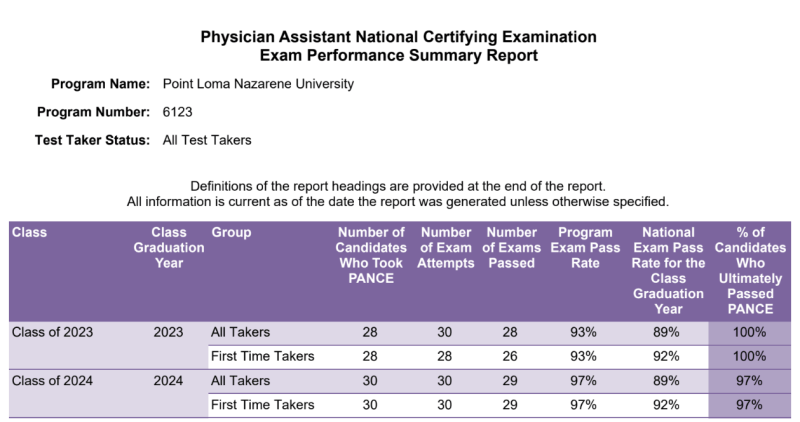Physician Assistant, M.S.M Program Goals
1. Recruit qualified individuals who successfully complete the Master of Science in Medicine degree at PLNU.
Rationale: The success of this program will be measured by the number of candidates completing the rigorous curriculum, and the PANCE pass rate indicating high-quality applicants.
| Class of | Cohort | Cum GPA | Cum Sci GPA | Patient Care Experience Hours | Service Hours |
|---|---|---|---|---|---|
| 2023 | 30 | 3.73 | 3.75 | 3332 | 349 |
| 2024 | 30 | 3.77 | 3.78 | 3603 | 580 |
| 2025 | 34 | 3.82 | 3.83 | 2839 | 750 |
| 2026 | 34 | 3.82 | 3.81 | 5073 | 909 |
| Class of 2023 | Class of 2024 | Class of 2025 | Class of 2026 | |
|---|---|---|---|---|
| Maximum entering class size (as approved by ARC-PA) | 30 | 32 | 34 | 34 |
| Entering class size | 30 | 31 | 34 | 36 |
| Graduates | 28 | 30 | ||
| * Attrition rate | 2 | 1 | ||
| **Graduation rate | 93% | 97% |
* **Attrition and graduation rates will be reported after graduation of the class in December and updated annually.
2. Maintain an accredited program that meets or exceeds the ARC-PA Standards for Accreditation of a Physician Assistant program ensuring that graduates have the requisite knowledge and skills for the practice of medicine as physician assistants.
Rationale: A quality education fosters innovation with teaching and learning opportunities tied to ongoing assessment to ensure graduates are prepared to enter into practice.
The ARC-PA granted Accreditation-Provisional status to the Point Loma Nazarene University Physician Assistant Program in 2021 and in March 2024 after the Provisional Monitoring visit.
Accreditation-Provisional is an accreditation status granted when the plans and resource allocation, if fully implemented as planned, of a proposed program that has not yet enrolled students appear to demonstrate the program’s ability to meet the ARC-PA Standards or when a program holding Accreditation-Provisional status appears to demonstrate continued progress in complying with the Standards as it prepares for the graduation of the first class (cohort) of students.
Accreditation-Provisional does not ensure any subsequent accreditation status. It is limited to no more than five years from matriculation of the first class. The program will be reviewed again in March 2026.
3. Foster a commitment to service to medically underserved communities.
Rationale: Placing students in centers that provide care to underserved populations helps to ensure that our PA students understand and are prepared to address the multiple factors contributing to health care disparities.
As demonstrated below, the program meets this goal by placing all students in underserved and/or rural locations with the desire to foster a long-term commitment to this healthcare practice. This commitment is realized through voluntary activities over the course of the didactic phase as well as placements in the Service month (August) and again in the Service elective clinical rotation.
| Class of | % with service in didactic phase% with underserved experience | % with underserved clinical rotations |
|---|---|---|
| 2023 | 100% | 100% |
| 2024 | 100% | 100% |
| 2025 | 100% | 100% |
| 2026 | 100% |
Students identify an issue from their service month and craft a small, achievable activity that contributes to a potential remedy which is then presented at the conclusion of their clinical year. Reflective papers written at the conclusion of the service elective, exit interviews with our graduates and subsequent employment with practices serving the underserved and marginalized will be collected and reviewed. Achievement of these goals will be updated annually.
4. Educate students in a collaborative team model that promotes critical thinking and medical problem-solving skills.
Rationale: Training health professions students together increases knowledge of and respect for other disciplines scope of practice, similarities in patient care and identifies potential areas of role overlap.
This curriculum integrates formal didactic instruction on healthcare professions with structured interprofessional experiences, including role-playing and team-based learning. Students from PA, Athletic Training, Kinesiology, and Integrative Wellness programs complete an evidence-based medicine course and engage online, with medical providers educating them on their careers. Students will also participate in multiple interprofessional education (IPE) events with NP, Pharm, OT, AT, nursing, and mental health students, emphasizing teamwork, communication, and role clarity. Students also gain hands-on experience at health fairs and street medicine teams alongside medical professionals. Faculty model interprofessional collaboration, and clinical sites provide PA students opportunities to work with diverse healthcare teams, assessed through student evaluations.
5. Graduate students with PANCE pass rates above the national average.
Rationale: The military and federal health services as well as all 50 states require that PAs pass the Physician Assistant National Certifying Examination in order to be licensed and practice.
